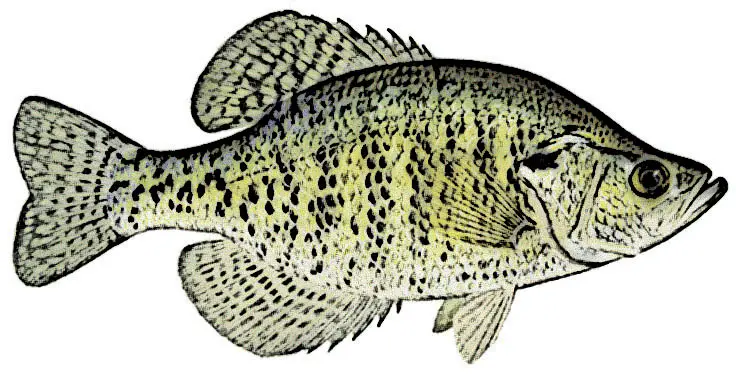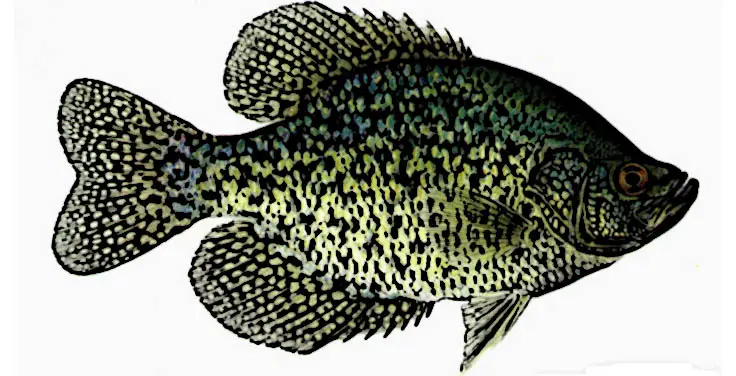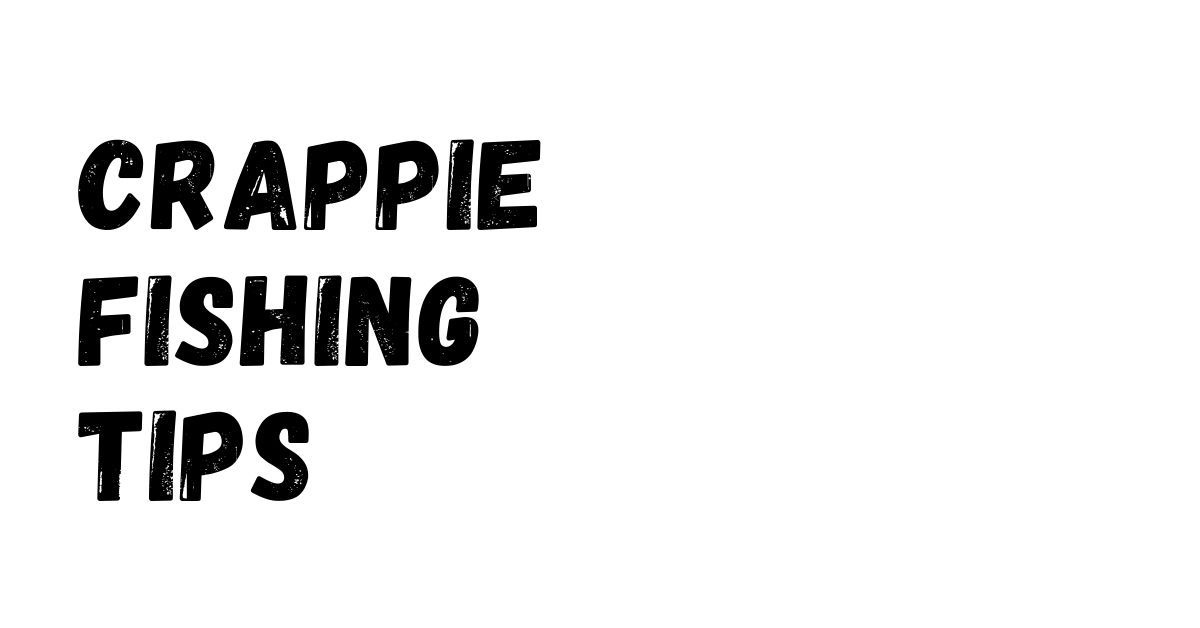Crappie are a popular panfish to catch throughout North America. If you know what you are doing, they can be caught year-round. In this guide, we will cover everything you need to know about crappie fishing. We will teach you how to identify crappies and where to fish for them. We will also cover the seasonal patterns of crappie, the equipment you will need to catch them, and give you a few additional tips to help you catch more crappie.
Types of Crappie
There are two different species of crappie: white crappie and black crappie.
White crappies are typically lighter in color and have silvery white sides with vertical bars. These fish commonly have 5 or 6 dorsal spines. They also have more elongated bodies compared to black crappies.

Black crappies are darker in color and their mottling pattern is not as neatly arranged as white crappie. Black crappies usually have 7 to 8 spines in their dorsal fin.

In terms of size, both kinds of crappie are very similar. Most of them will measure around 4 to 8 inches in length and weigh under 2 pounds. If you catch unusually large crappie it may measure upwards of 19 inches and could weigh over 4 lbs, but these are very very rare.
Where to Catch Crappie
Black crappies tend to prefer clear waters with very little or no current. They like areas with a lot of aquatic vegetation. White crappies can be found in more murky waters. You can fish for crappies in lakes, reservoirs, and large rivers.
Crappies tend to form schools and feed early in the morning, so fishing mornings can be a great time to fish for them. The season can also affect where you are most likely to catch crappie, so we’ll cover how to fish them in each season shortly.
What Do Crappie Eat?
Crappie have a varied diet, but they primarily feed on smaller fish, insects, crustaceans, and zooplankton. What they feed on will largely depend on the body of water they are in.
Seasonal Patterns
Fall
Early in the season around September, crappies will move from their shallow weedy hangouts into deeper waters. In smaller lakes, they tend to move near vegetation or structure in the 15-25 feet depth range. When it gets colder they may even move to the 25-35 foot depth range in deeper basins. Look for them near drop-offs or near the edge of flats.
Winter
In the winter crappie fishing can be very productive if you’re fishing the right areas. Look for deeper ledges and areas with drop-offs and structure where the crappie may be grouping together. Anything with rock piles, stumps, or piles of other structure near deep edges is a good bet. This can be near deep boat docks or along creek banks or bridges.
Creek mouths can also be great places to fish because smaller baitfish tend to group together in these areas. This can make it very attractive to hungry crappies.
Spring
When the water warms up in the springtime, fish shallow areas that are teeming with activity. Usually, this will be areas that get a lot of sunlight which helps to create a healthy zone for baitfish. Your best option is to look for healthy zones in coves, creeks, and canals.
Late spring to early summer is the crappie spawning season. The fish ravenously feed in the weeks leading up to spawning. Shallow waters along the banks of lakes are ideal during this time. Crappies like to spawn in shallow areas with solid bottoms. This can be rocks, logs, or other hard bottoms surrounded by cover. Most often this will be on lake floors. A helpful tip is to pay attention to the areas where crappie previously spawned. They tend to return to the same spawning sites, assuming the conditions haven’t changed drastically.
Summer
Fishing the summertime can still be pretty productive, though crappies are not feeding as aggressively as during the spawning season. After spawning crappie move into deeper waters and are a little harder to locate.
Look for them in waters around 20-30 feet deep. The idea spot will be by a drop off where schools of smaller fish are hanging out. If there is submerged cover like dead trees or brush, then this is a pretty likely spot. Crappies like to stay really close to cover, so placing your bait just beyond the edge of it can work wonders.
The weather will also affect where you will find crappies to a degree. They like to stay near cover when the sun is shining brightly in the summer heat. On cloudy, windy days, you may find them venturing out to hunt for food.
Best Time to Catch Crappie
Crappie have pretty good vision, so they are able to feed productively in low light situations. This is why early morning is one of the best times to catch them. The water is cooler in the morning and then can feed in low light, so they will venture from their cover and feed. Just before the sun rises to about 2 hours after sunrise you can do some of your best crappie fishing.
Crappie Fishing Equipment
Rods and Reels
Most often we recommend a spinning rod and reel for fishing crappie. These are the easiest to use and work great for fishing the shallow waters. Use a rod around 4 to 5 feet long with a slow or medium action. You will also want to use an ultralight or light spinning reel with a fast gear ratio.
Baitcasting reels can also work well if you’re trolling for crappie or fishing near deeper structure. A 6 to 12-foot fast action rod is a good choice. Longer rods will allow you to cast further but for trolling a 6-foot rod will be fine.
You can also use cane poles and fly rods for crappie. If you’re going to be fishing with a cane pole a long 12 to 20-foot pole is a good choice. You will want a stiffer fast action rod for this.
If you are using a fly rod you will still want a fast action rod with a good amount of stiffness. Stick with something around a 4 to 6 weight rod.
The key is to remember that crappies are not a very large fish, so you want something with a good amount of sensitivity so you can feel light bites and use lighter tackle.
Lures and Baits
Spinners
The flash and vibration of a good spinnerbait lure will appeal to crappies by mimicking minnows, which is one of their favorite foods. They are also great because they will work even in muddy murky waters. When the water is too dark or cloudy for crappies to fish by vision, the vibration of a spinnerbait works well.
Crankbaits
In the summertime, pulling crankbaits for crappie fishing is a highly productive method used by many top anglers. When the water is warmer try using this method over deeper flats, main channels, or over other structure where the crappie will be schooling.
Jigs
Many anglers strongly prefer jigs for their crappie fishing. Jigs can be used in every season to catch crappie effectively. Crappie are smaller fish, so just remember not to use too large of a jig. You can also try jigs that resemble shad or minnow since they are commonly eaten by crappie.
Live Bait
Using live bait is almost always effective no matter what kind of fish you are targeting. For crappie fishing, minnows are very popular, but you can also use worms and insects too.
Fishing Line
Since crappies aren’t very big, you can get away with a light line. A lighter line will offer better sensitivity and be invisible, which is a good thing. For crappie fishing, you can use monofilament, braided or fluorocarbon fishing line. Anything between 2 to 8-pound test line should be fine for these smaller fish.
Mono has the benefit of having a little bit of stretch to it, which can help when it comes to setting the hook. It also floats a little bit, so it is good for fishing shallows
Braided line is generally preferred for fishing deeper waters for crappie. It doesn’t stretch and has a fast sink rate, which makes it ideal for these conditions. Braided line is also sensitive, which makes it good for feeling lighter crappie bites.
Fluorocarbon line is almost invisible underwater. Crappie are known for having good vision, so a good fluoro line is always a safe bet.
You can also use a sinking fly line. This is generally used for shallower waters ranging from 2 to 5 feet deep. Often this is something used during spawning when the crappie are in the shallows.
Hooks
For crappie fishing stick with a 2, 4, or 6 size hook. Aberdeen or circle hooks are commonly used. The long shank on aberdeens makes them easy to remove. Circle hooks have the benefit of increasing the likelihood of a good corner lip hookset. If you’re having problems with gut hooking you may want to use a circle hook.
Tips to Catch More Crappie
Slow it Down
Generally, for crappie fishing, slow and steady retrieves tend to work best. You will get more action if you slow things down. If you’re not getting any bites, try slowing your tempo down a bit and see if that adjustment helps you catch more fish.
Think Shallow
You will usually catch crappie in waters ranging from 3 to 5 feet deep. In the hottest summer months they will move into deeper sections of water, but generally staying in the shallows is your best option.
Gentle Hooksets
Crappies are known for having fragile mouths. If you set your hook too aggressively you will end up tearing your way through their mouths. A gentle wrist flick is all you need. You just need to barely tighten the line to get a good hook set.
Related Posts:
Bluegill Fishing Tips
Pike Fishing Tips
How to Catch American Shad
